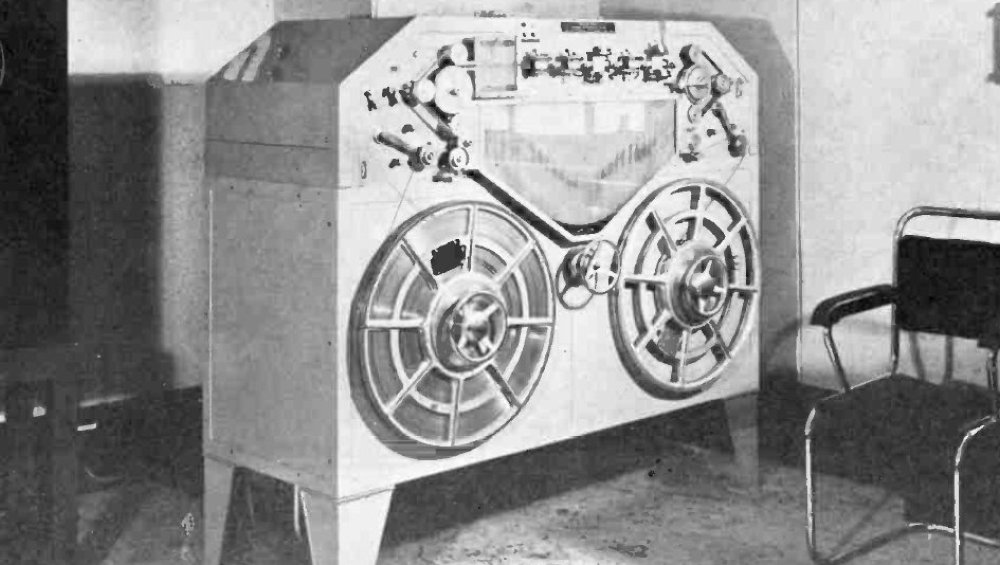 The first tape recorder in a BBC studio (photo by Douglas Hallam, Jr./public domain)
The first tape recorder in a BBC studio (photo by Douglas Hallam, Jr./public domain)Marconi achieved this in 1896 in England, though the groundwork was laid by two other scholars:
- James C. Maxwell, who theoretically developed the fundamental principles of electromagnetism in 1873
- and Heinrich Hertz, who confirmed Maxwell`s theory by generating electromagnetic waves in 1888.
As a result, it was Hertz who demonstrated the technical workings of radio.
The Birth of Radio
Until the end of World War I, radio remained solely instrumental, serving military and maritime communication purposes. The first radio station, KDKA, was established in Pittsburgh in 1920, coinciding with the announcement of the Harding-Cox presidential campaign results. From that point, the development of American radio accelerated remarkably. While it wasn`t yet a tool for public communication, it was an expensive hobby that allowed society to connect with culture and express individual opinions on its creations and values.
Soon, the average family could afford a radio, which politicians quickly took advantage of. Radio became not only a source of information but also a platform for public debate. It also became a tool for propagandists working with Hitler, Mussolini, and Stalin. Hitler himself summarized its functionality and usefulness best: "Without cars, sound films, and radio, there would be no victory for National Socialism."
Beyond the political sphere, radio also entered the realm of religious practices. A year after regular broadcasting began, Pittsburgh`s KDKA transmitted a Sunday mass every week from a local church.
The development of radio as a mass communication medium in the 1920s and 1930s was closely tied to the activities of corporations with the technical and organizational capacity to produce radio receivers. This production quickly reached mass proportions due to simple technology, and radio became a nationalized, centralized institution that directed its content to a homogeneous audience. This form of radio is perhaps best expressed by the words of Hans Fritsche, head of radio propaganda and chief commentator for German radio: "Radio must reach everyone - or it reaches no one."
The Evolution of Radio
The period when radio reached a single, large audience - the nations - did not end immediately. In the television era, despite remaining secondary to its "younger sister," radio retained significance, though other more modern media came to the forefront: first tapes, then hi-fi, video, satellite and cable TV, computer games, CDs, and digital technology. Through rapid technical development, radio attracted new listeners who previously found nothing of interest on its airwaves.
Contemporary radio presents a true mosaic of legal, organizational, and program types. Alongside major national public broadcasters, there are small pirate stations. The owners of commercial stations range from large media corporations to private individuals. Additionally, small community stations exist, their reach often limited to a town or neighborhood. Fully professional radio operates side-by-side with entirely amateur radio, revealing that radio is an extraordinarily diverse institution, resistant to a single, definitive model.
In Europe, among 9,000 radio stations, five types can be distinguished:
- National programming channels belonging to public broadcasters (most of these have 2-4 channels);
- National commercial networks like Classic FM, Radio Zet, or P4 (Norway);
- Private networks comprising local stations, such as Energy, Sky Rock, and Nostalgie; the owners of such networks typically establish their own advertising agencies to service all the stations within the network;
- Independent regional or local stations, often operating in large metropolitan areas or local communities, usually sharing frequencies with other stations;
- Private local stations existing in countries where creating national private networks is restricted or prohibited.
Demonopolization, decentralization, revolutionary changes in broadcasting techniques, the dominant role of television, and intense competition are the primary factors that have driven the transformation of radio. The last factor likely concerns radio professionals the most, who strive to maintain their place in the market through various strategies. The first sign of this is the shift away from the program schedule model, introduced by John Reith, head of the BBC, which involved a single station`s program encompassing all radio functions. Today, listeners can choose what they want to hear, and stations of various themes are emerging rapidly.
For example, a teenager listening to techno or disco won’t tune into the frequency of "Channel Two," dominated by classical music; instead, they’ll opt for a station like RMF FM, where they’re sure to hear their favorite "track." Information-seekers no longer wait for hourly news updates on commercial radio but instead comfortably listen to channels like France Info or BBC 5 Live, offering constant updates from around the world. Youth with unresolved problems can find a kindred spirit on BBC Radio 1 or Radio Bayern.
What is radio, then? Its essence is best captured by the words of A. Faus during the Second International Radio Week in Spain:
"RADIO IS A FULLY MATURE COMMUNICATION MEDIUM AWARE OF ITS ROLE, DISTINCT PURPOSE, AND DIVERSE TECHNIQUES AND METHODS TO ACHIEVE IT."
COMMERCIAL BREAK
New articles in section History of the media
The History of The New York Times. All the news that's fit to print
Małgorzata Dwornik
In the heart of 19th-century New York, when news from across the world traveled via telegraph and the newspaper was the voice of public opinion, two ambitious journalists created a modest four-page daily that would eventually become a legend.
FORTUNE. The story of the most exclusive business magazine
Małgorzata Dwornik
Half of the pages in the pilot issue were left blank. Only one printing house in the country could meet the magazine’s quality standards. They coined the terms "business sociology" and "hedge fund". They created the world’s most prestigious company ranking. This is the story of Fortune.
History of Le Soir. A Belgian daily once free for ground floor readers
Małgorzata Dwornik
It started with an unusual sales policy and articles written personally by the king. This is where the comic hero Tintin made his name. The "fake edition" from the II World War went down in history. "Le Soir" more than once found itself targeted by authorities, censors, and even... terrorists and hackers.
See articles on a similar topic:
It all began with a one-letter typo. The story of Oprah Winfrey
KFi
One misplaced letter on her birth certificate turned Orpah into Oprah, and one charismatic hour each afternoon turned a local talk show into a cultural super-power. Here’s the story of a girl in potato-sack pants claimed the throne of TV and talk-shows.
The History of TOLOnews. Free media pioneers from afghanistan
Małgorzata Dwornik
For the first 10 years of its existence, TOLOnews journalists seemed to have clashed with nearly every prominent figure in the country. In 2016, they received France’s Freedom of Information Award. And all this in a country considered the most dangerous place for journalists. After the Taliban returned to power - even more so.
Barbara Walters. The queen of impossible interviews from ABC television
Małgorzata Dwornik
Barbara Walters began her media career in 1951 with advertising and producing a children's program. In the 1960s, she shattered the glass ceiling. Her interviews on NBC brought her to the height of popularity, but it was her programs on ABC that earned her the title of the queen of television.
The Fourth Estate in America: Sex and Violence
Urszula Sienkiewicz
The media in the United States include many "business sharks" who prioritize their own interests and corporate profits over the public good. The average American spends 8 hours a day on mass media - 4 hours on television, 3 on radio, half an hour on recreational music, and the remaining minutes on reading.





























